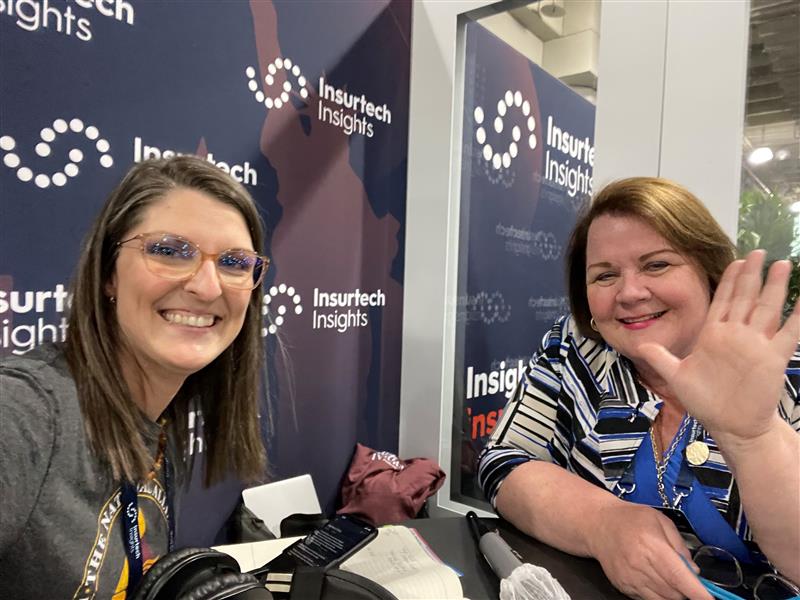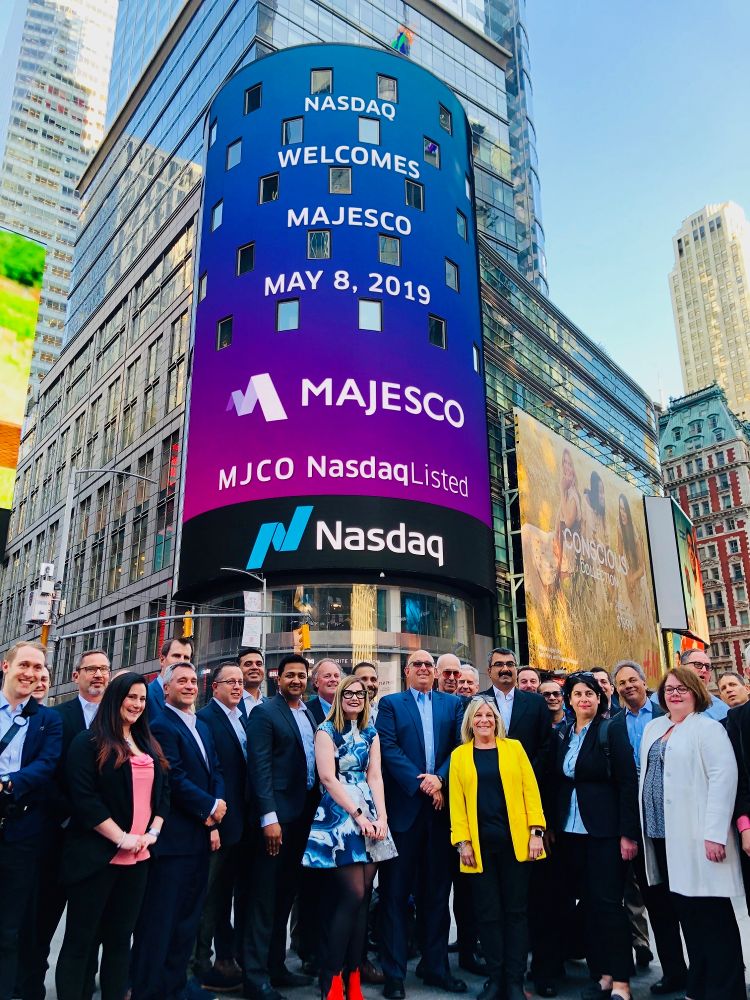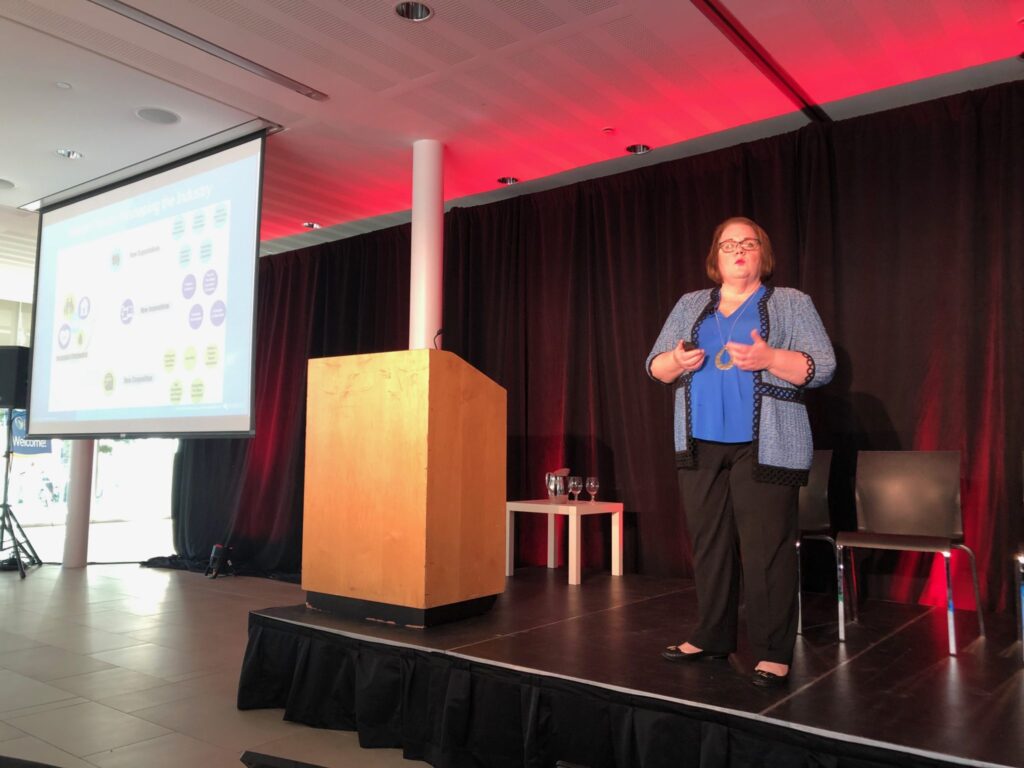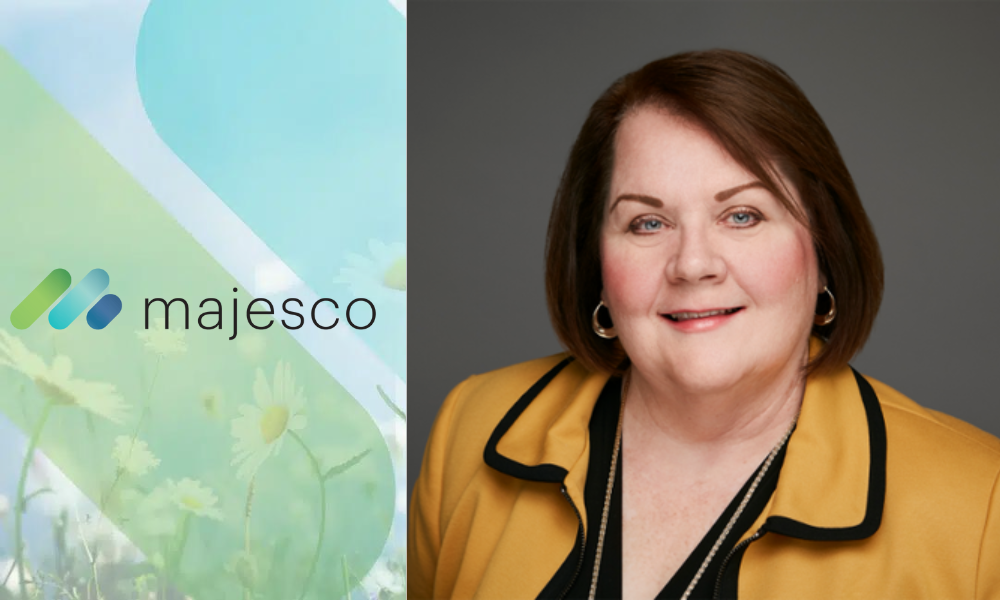Denise Garth is a familiar figure on the insurance industry leader’s circuit. Performing the dual role of Chief Strategy Officer and Chief Marketing Officer for Majesco, her career began back in the early eighties, when she bucked all trends and pursued a degree in computer science and mathematics instead of following expectations and entering the world of medicine.
As a female maths and technology-whizz, she was a lone wolf in the early days of computing, often the only woman in her class. As such, Denise has experienced vast changes within the industry on multiple levels – and has also helped to drive them.
Today, she shapes corporate decisions and oversees diverse business strategies. She also spearheads global marketing initiatives and is known for her keen eye for industry trends.
Respected for her strong work ethic which has shaped her 40+ year career, it’s no surprise that she meets me promptly for our interview at the crack of dawn, US time, having already prepped for the day with a couple of cups of coffee.
Let’s start at the beginning. Can you tell us about your early experiences as a tech pioneer, studying mathematics and computer science back in the late seventies and early eighties?
Certainly. It was a transformative time for me. Originally, I had plans to become a doctor due to my passion for mathematics and science. However, by my sophomore year, the all-night labs didn’t quite align with my vision. At that time, computer science was emerging, and the blend of maths and computer science fascinated me. I transitioned into the world of technology, starting as a programmer for the first insurance company I worked for.
I was one of very few women in IT, and it was a period of pioneering technology in the insurance sector. The early experience of understanding the intricate workings of insurance, from property and casualty to life and annuity, set a solid foundation for my career.

Being a female in the technology landscape in the eighties must have been challenging. How did you navigate it?
It was a challenging time, as the tech industry was predominantly male-dominated. I was fortunate to work in a company where the CEO believed in talent and was supportive. Despite being one of the few women in IT, I made friends across various departments through my role, which involved working in different business areas. This support network became crucial when I was tasked with leading a major project for the company, turning a high-risk initiative into a successful one. While it wasn’t without challenges, having a diverse team and a collaborative, team-oriented approach played a significant role in overcoming obstacles.
I was fortunate to have a supportive spouse and network of colleagues. My husband had a similar situation career wise. He was an elementary teacher and it was somewhat unheard of to have men as elementary teachers at that time so we had similar experiences but in different professions.
I was also lucky in the first company I worked for because the CEO at the time was really what I would call a renaissance man. He knew everybody in the company, he talked to everybody in the company and he really believed in talent. The experience of being one of the few women in IT allowed me to build connections across various departments and levels, fostering a collaborative environment. This collective approach was pivotal when leading major projects, including redefining compensation structures for agents, and it contributed to the success of those initiatives.
You were named as one of the Software Report’s Top 50 Women Leaders in SaaS in 2020. How can the industry attract more women into the tech space, and what are they doing right currently?
In my career, even during the era of professional suits and conservative attire, I stood out with my brightly coloured shirts, high-energy and distinguishable laugh. A bit of rebellion, perhaps, but it conveyed the message that I wouldn’t conform to monotony. As a woman, I’ve learned the importance of self-belief, self-awareness, and strength.
The industry has made progress with more women rising to leadership roles across insurance, reinsurance, brokerage, and technology companies. This diversity of thinking, combining right-brain and left-brain approaches, fosters collaboration and is crucial for innovation. Leaders who embrace this diversity contribute to the industry’s evolution.
There’s an exciting shift happening as a growing group of women in the industry actively support and collaborate with each other. This collaborative spirit extends beyond titles—whether it’s being an InsurTech leader, an influencer, a manager, an architect, or an executive. In the past five years, I’ve witnessed a transformation where women are increasingly supportive and collaborative across organisations within the industry.
Unlike decades ago, when there might have been a competitive edge among women, today’s network is empowering and uplifting. Women are creating a powerful movement, reaching out to connect, share experiences, and provide support. This collaborative approach not only benefits women but also sets an example for inclusive collaboration, embracing diversity in all its forms that ultimately is beneficial for each company.
How does your current role intersect with technology and product development?
I work closely with the product team to align our strategies with emerging marketplace trends. We engage in our own primary research to understand customer expectations and insurer priorities that provide insights that directly influence our technological and product perspectives. It is also important as we evaluate and develop a thesis on buying other technology companies to meet the needs and demands in our industry. It’s a dynamic process where staying ahead in the technology curve is crucial.
The industry is undergoing a remarkable transformation, and technology is playing a pivotal role in shaping its future. I’m privileged because my role revolves around anticipating these changes, aligning our strategies with market demands, and ensuring Majesco remains at the forefront of innovation in the rapidly evolving insurance landscape.
This is, without a doubt, the most exciting period in my career so far, because we are witnessing innovations and changes that surpass anything I’ve experienced before.
Can you give us the elevator pitch on Majesco’s role in the insurance industry?
Majesco is a market leading technology provider catering to the insurance industry, spanning property and casualty, life and annuity, and health. Our mission is to serve as a source of value creation through innovative solutions that help insurers effectively navigate and manage these risks, fostering economic prosperity even in challenging times. It’s about providing your next now.
What is Majesco’s current vision and focus on innovation?
Our vision centres on being a catalyst for the re-imagination of insurance, aligning with the evolving expectations of customers and the changing landscape of risk. Majesco strives to be a source of value creation for its customers by prioritising innovation.
We recognise the shifting dynamics in the marketplace, including changing customer expectations and evolving risk scenarios. In response, Majesco is dedicated to providing advanced technology solutions and a higher level of commitment to digital transformation to ensure success in the industry.
We offer a comprehensive portfolio of cloud-native platform solutions with a next-gen architecture. These solutions are characterised by being cloud-native, headless, API-enabled, microservices-driven, and most importantly, embedded with analytics including Gen AI. The portfolio includes intelligent core systems for policy, billing, and claims, loss control, an underwriting platform for group benefits, enterprise rating, distribution management, a digital platform with low-code, no-code capabilities and portal solutions for agents and customers, absence management, and a robust set of data and analytics.
Majesco has recently incorporated generative AI and AI/ML models into its core systems and loss control system, enhancing operational efficiencies and addressing specific use cases. Data and analytics are a core strategy, aiming to empower insurers with the tools needed for effective underwriting, service, and claims management.
You joined Majesco almost nine years ago and now have an active role in media and marketing as well as strategy. How has that fitted into your official role as a Chief Strategy Officer?
Chief Strategy Officers often have marketing as part of their role. It makes sense because strategy is really about understanding what’s happening in the market that you’re serving, understanding the trends in the market, and how they apply to the strategy of an organisation. You’ve really got to be able to apply that understanding to a marketing perspective.
Working at ACORD, an industry standards organisation, and later as an industry analyst at Strategy Meets Action, exposed me to diverse perspectives globally. This visibility and engagement laid the groundwork for my role today.
I’m naturally a very curious person. I always like to learn new things. I spent a lot of time looking outside the industry to where technology was being applied and how that was going to impact the insurance industry. It was a natural evolution and for Majesco, it helps bring perspectives into the organisation at what’s happening in the market.
I also spend time with our customers discussing market trends, our research, and analysing about our findings. At least once a year, there’s a group of customers that want me to come in and talk about the latest that I’m seeing in the marketplace.

From your unique perspective, what’s the most formidable challenge insurers are grappling with in their digital transformation journey?
Legacy technology and business operating models are the juggernauts in the room. Despite attempts to modernise, many insurers are still shackled by legacy systems. Even if a new modern system was introduced in the past decade, it is likely on-premise rather than in the cloud and heavy customisation often renders it inflexible, difficult and expensive to upgrade.
This on-premise behemoth becomes a web of complexity as layers upon layers are added over time. The result? Hindered agility in bringing new products and digital experiences to market. Inability to meet new customer expectations on engagement and process. The legacy landscape obstructs insurers from responding to the shifts in the market effectively.
Business today operates in a different realm. It’s a landscape shaped by a younger customer – both individuals and businesses – demographic and a demand for more personalised and innovative products. Insurers grapple with outdated models that fail to meet the evolving needs of a changing risk landscape, new expectations, new technologies, and a clientele seeking enhanced value for their insurance investments. The shift isn’t just demographic; it’s a transformation of the entire insurance paradigm, emphasising risk management and prevention over traditional claims payout. This necessitates a seismic change in both business models and technology.
The intertwining challenges of legacy technology and business models are like a Gordian knot. Untangling and rethinking both is imperative. We need to break free from old paradigms, embracing a world that’s vastly different from what it was a decade or two ago.
From personalised underwriting to value-added services that mitigate risk, insurers are navigating uncharted territories. It’s a call for a profound transformation in both mindset and technology, acknowledging that the role of insurance extends beyond claims payout to proactive risk management.
What innovative solutions do you see emerging to tackle these challenges?
It’s a labyrinthine issue. With insurers struggling to get rate increases approved, it’s time to consider a paradigm shift. Instead of exiting markets, what if we could offer different products that address risk more dynamically?
Parametric insurance steps into the spotlight, offering unique solutions. It might not be the traditional premium value, but it maintains relationships and provides value, crucial in an ever-changing market.
The spectrum is broad. It’s about reimagining traditional products by enveloping them in technology or value-added services. Telematics, a familiar concept for over a decade, is evolving. Beyond just tracking how much you drive, it’s now about how and when you drive.
This shift caters to the changing lifestyles post-pandemic, offering potential reductions in insurance costs. For property insurance, leveraging IoT devices—from smoke detectors to wearables for construction workers—opens new avenues. These devices, coupled with innovative approaches, extend beyond risk management to enhancing people’s lives.

It sounds like technology is enabling a holistic approach to insurance. Can you share examples where this perspective is making a significant impact?
Absolutely. The power of technology extends beyond just mitigating risks; it’s about enhancing lives. Take, for instance, an insurance company’s innovative product. By using IoT devices in homes, they don’t stop at monitoring risk. They go further using these devices to help the elderly age safely in their homes. Alerts for medication, reminders for doctor’s appointments, and fall detection provide a holistic experience. It’s about redefining insurance to be more than a risk mitigator; it’s about being a partner in people’s and businesses’ lives.
Loss control for properties is another arena ripe for transformation. With property values and repairs soaring, insurance needs to keep pace. Leveraging technology to reassess and adapt coverage for the increased value of properties is a logical step. The potential is vast, presenting an opportunity to redefine insurance in a way that aligns with the evolving dynamics of our world. It’s not just about reacting to risk; it’s about proactively enriching and securing lives and businesses.
Underinsurance seems to be a significant issue, especially in the wake of recent and numerous climatic events. How can technology play a role in closing this gap?
The issue of underinsurance often surfaces in the aftermath of tragic events, such as the Colorado fires. People assume they are adequately covered, only to discover their coverage falls short, given the surge in property values. The escalating reconstruction costs further compound the problem.
Reconstruction costs have skyrocketed, but not every property is assessed appropriately. We have tools today, like self-surveys, video assessments, and aerial imagery, that empower individuals and businesses to assess their own properties. This not only benefits the insured by helping them understand potential underinsurance but also aids insurers in gaining a more accurate assessment of their portfolio.
Armed with this knowledge, insurers can secure more appropriate reinsurance coverage, ensuring a win-win situation for everyone involved. It’s about leveraging technology to bridge gaps, enhance risk understanding, and engage with customers in a way that suits their preferences.
What inspires you most about the current state of the industry?
The industry is experiencing a rekindling of its underlying noble cause—to underpin people’s lives, businesses, and the economy. The responsibility is to help individuals and businesses navigate the constant changes, be it climate change, demographics, geopolitical shifts, or technological advancements.
Therein lies the inspiration.
Leveraging technology to manage and, in some cases, reduce or eliminate risk. It’s a return to the industry’s roots, steering towards a world that requires thoughtful and innovative risk management.
Integrating technologies like generative AI requires thoughtful consideration, ensuring operational impact. The key is not to fear failure but to experiment courageously. The industry’s natural risk aversion needs to be balanced with a willingness to think big, start small, and fail fast. With cloud-native core systems providing agility and flexibility, insurers can bring products to market rapidly, adapting to the swift changes in the world around them.
Insurance plays a crucial role in driving innovation by managing risks associated with new endeavours. Whether it’s space exploration, novel food sources, gig-economy businesses, or advanced vehicles, all innovations come with inherent risks.
Insurers create niche products initially to address unique risks, eventually transforming them into mainstream offerings. The insurance industry becomes an enabler for progress, allowing society to explore uncharted territories and create groundbreaking solutions.
What’s your vision for the insurance of tomorrow?
There’s a vast array of risks emerging in our everyday lives, from robots serving in restaurants to changes in transportation methods. As technology evolves, new risks appear, necessitating innovative insurance solutions.The industry’s ability to rapidly adapt and address these evolving risks ensures a comprehensive and proactive approach to risk management. Insurance allows risk-takers and innovators to challenge, to dare, to create, and to innovate at the speed of risk.
Interview by Joanna England

Joanna England is an award-winning journalist and the Editor-in-Chief for Insurtech Insights. She has worked for 25 years in both the consumer and business space, and also spent 15 years in the Middle East, on national newspapers as well as leading events and lifestyle publications. Prior to Insurtech Insights, Joanna was the Editor-in-Chief for Fintech Magazine and Insurtech Digital. She was also listed by MPVR as one of the Top 30 journalist in Fintech and Insurtech in 2023.









